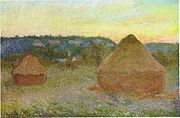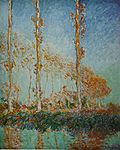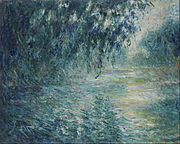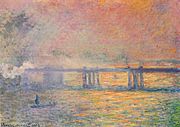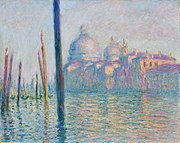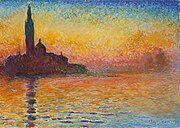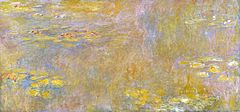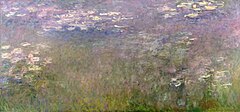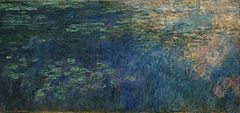Claude Monet
Claude Monet | |
|---|---|
 Monet c. 1899 | |
| Born | Oscar-Claude Monet 14 November 1840 |
| Died | 5 December 1926 (aged 86) |
| Education | |
| Years active | 1865–1926 |
| Known for | Painting |
| Notable work | |
| Movement | Impressionism |
| Spouses | |
| Children | |
| Patron(s) | |
| Signature | |
Oscar-Claude Monet (UK: /ˈmɒneɪ/, US: /moʊˈneɪ, məˈ-/; French: [klod mɔnɛ]; 14 November 1840 – 5 December 1926) was a French painter and founder of impressionism painting who is seen as a key precursor to modernism, especially in his attempts to paint nature as he perceived it.[1] During his long career, he was the most consistent and prolific practitioner of impressionism's philosophy of expressing one's perceptions of nature, especially as applied to plein air (outdoor) landscape painting.[2] The term "impressionism" is derived from the title of his painting Impression, soleil levant, which was first exhibited in the so-called "exhibition of rejects" of 1874–an exhibition initiated by Monet and like-minded artists as an alternative to the Salon.
Monet was raised in Le Havre, Normandy, and became interested in the outdoors and drawing from an early age. Although his mother, Louise-Justine Aubrée Monet, supported his ambitions to be a painter, his father, Claude-Adolphe, disapproved and wanted him to pursue a career in business. He was very close to his mother, but she died in January 1857 when he was sixteen years old, and he was sent to live with his childless, widowed but wealthy aunt, Marie-Jeanne Lecadre. He went on to study at the Académie Suisse, and under the academic history painter Charles Gleyre, where he was a classmate of Auguste Renoir. His early works include landscapes, seascapes, and portraits, but attracted little attention. A key early influence was Eugène Boudin, who introduced him to the concept of plein air painting. From 1883, Monet lived in Giverny, also in northern France, where he purchased a house and property and began a vast landscaping project, including a water-lily pond.
Monet's ambition to document the French countryside led to a method of painting the same scene many times so as to capture the changing of light and the passing of the seasons. Among the best-known examples are his series of haystacks (1890–1891), paintings of Rouen Cathedral (1892–1894), and the paintings of water lilies in his garden in Giverny that occupied him continuously for the last 20 years of his life.
Frequently exhibited and successful during his lifetime, Monet's fame and popularity soared in the second half of the 20th century when he became one of the world's most famous painters and a source of inspiration for a burgeoning group of artists.
Biography
[edit]Birth and childhood
[edit]Claude Monet was born on 14 November 1840 on the fifth floor of 45 rue Laffitte, in the 9th arrondissement of Paris.[3] He was the second son of Claude Adolphe Monet (1800–1871) and Louise Justine Aubrée Monet (1805–1857), both of them second-generation Parisians. On 20 May 1841, he was not baptised in the local Paris church, Notre-Dame-de-Lorette, as Oscar-Claude, but his parents called him simply Oscar.[3][4] Although baptised Catholic, Monet later became an atheist.[5][6]
In 1845, his family moved to Le Havre in Normandy. His father, a wholesale merchant, wanted him to go into the family's ship-chandling and grocery business,[7][8] but Monet wanted to become an artist. His mother was a singer, and supported Monet's desire for a career in art.[9]
On 1 April 1851, he entered Le Havre secondary school of the arts.[10] He was an apathetic student who, after showing skill in art from a young age, began drawing caricatures and portraits of acquaintances at age 15 for money.[11] He began his first drawing lessons from Jacques-François Ochard, a former student of Jacques-Louis David.[11] In around 1858, he met fellow artist Eugène Boudin, who would encourage Monet to develop his techniques, teach him the "en plein air" (outdoor) techniques for painting and take Monet on painting excursions.[12][13] Monet thought of Boudin as his master, whom "he owed everything to" for his later success.[14]
In 1857, his mother died.[15] He lived with his father and aunt, Marie-Jeanne Lecadre; Lecadre would be a source of support for Monet in his early art career.[13][15]

Paris and Algeria
[edit]From 1858 to 1860, Monet continued his studies in Paris, where he enrolled in Académie Suisse and met Camille Pissarro in 1859.[16][17] He was called for military service and served under the Chasseurs d'Afrique (African Hunters), in Algeria, from 1861 to 1862.[18] His time in Algeria had a powerful effect on Monet, who later said that the light and vivid colours of North Africa "contained the gem of my future researches".[19] Illness forced his return to Le Havre, where he bought out his remaining service and met Johan Barthold Jongkind, who together with Boudin was an important mentor to Monet.[12]

Upon his return to Paris, with the permission of his father, he divided his time between his childhood home and the countryside and enrolled in Charles Gleyre's studio, where he met Pierre-Auguste Renoir and Frédéric Bazille.[15][21][22] Bazille eventually became his closest friend.[14] In search of motifs, they traveled to Honfleur where Monet painted several "studies" of the harbor and the mouth of the Seine.[23] Monet often painted alongside Renoir and Alfred Sisley,[24] both of whom shared his desire to articulate new standards of beauty in conventional subjects.[25]
During this time he painted Women in Garden, his first successful large-scale painting, and Le déjeuner sur l'herbe, the "most important painting of Monet's early period".[24][26][27] Having debuted at the Salon in 1865 with La Pointe de la Hève at Low Tide and Mouth of the Seine at Honfleur to large praise, he hoped Le déjeuner sur l'herbe would help him break through into the Salon of 1866. He could not finish it in a timely manner and instead submitted The Woman in the Green Dress and Pavé de Chailly to acceptance.[15][28] Thereafter, he submitted works to the Salon annually until 1870, but they were accepted by the juries only twice, in 1866 and 1868.[12] He sent no more works to the Salon until his single, final attempt in 1880.[12] His work was considered radical, "discouraged at all official levels".[21]
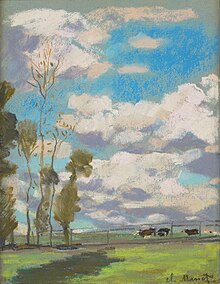
In 1867 his then-mistress, Camille Doncieux—whom he had met two years earlier as a model for his paintings—gave birth to their first child, Jean.[13] Monet had a strong relationship with Jean, claiming that Camille was his lawful wife so Jean would be considered legitimate.[29] Monet's father stopped financially supporting him as a result of the relationship. Earlier in the year Monet had been forced to move to his aunt's house in Sainte-Adresse.[15][28] There he immersed himself in his work, although a temporary problem with his eyesight, probably related to stress, prevented him from working in sunlight.[15][28][12] Monet loved his family dearly, painting many portraits of them such as Child With a Cup, a Portrait of Jean Monet. This painting in particular shows the first signs of Monets' later famous impressionistic work.[30]
With help from the art collector Louis-Joachim Gaudibert, he reunited with Camille and moved to Étretat the following year.[14][15] Around this time, he was trying to establish himself as a figure painter who depicted the "explicitly contemporary, bourgeois", an intention that continued into the 1870s.[15][31][21][22] He did evolve his painting technique and integrate stylistic experimentation in his plein-air style—as evidenced by The Beach at Sainte-Adresse and On the Bank of the Seine respectively, the former being his "first sustained campaign of painting that involved tourism".[15][28]
Several of his paintings had been purchased by Gaudibert, who commissioned a painting of his wife, alongside other projects; the Gaudiberts were for two years "the most supportive of Monet's hometown patrons".[12][29] Monet would later be financially supported by the artist and art collector Gustave Caillebotte, Bazille and perhaps Gustave Courbet, although creditors still pursued him.[12][21]
Exile and Argenteuil
[edit]
He married Camille on 28 June 1870, just before the outbreak of the Franco-Prussian War.[32] During the war, he and his family lived in London and the Netherlands to avoid conscription.[15][16] Monet and Charles-François Daubigny lived in self-imposed exile.[16][A] While living in London, Monet met his old friend Pissarro and the American painter James Abbott McNeill Whistler, and befriended his first and primary art dealer, Paul Durand-Ruel, an encounter that would be decisive for his career. There he saw and admired the works of John Constable and J. M. W. Turner and was impressed by Turner's treatment of light, especially in the works depicting the fog on the Thames.[12][15][33][34] He repeatedly painted the Thames, Hyde Park and Green Park.[15] In the spring of 1871, his works were refused authorisation for inclusion in the Royal Academy exhibition and police suspected him of revolutionary activities.[35][32] That same year he learned of his father's death.[12]
The family moved to Argenteuil in 1871, where he, influenced by his time with Dutch painters, mostly painted the Seine's surrounding area.[31][36] He acquired a sailboat to paint on the river.[12] In 1874, he signed a six-and-a-half year lease and moved into a newly built "rose-colored house with green shutters" in Argenteuil, where he painted fifteen paintings of his garden from a panoramic perspective.[31][37] Paintings such as Gladioli marked what was likely the first time Monet had cultivated a garden for the purpose of his art.[31] The house and garden became the "single most important" motif of his final years in Argenteuil.[37] For the next four years, he painted mostly in Argenteuil and took an interest in the colour theories of chemist Michel Eugène Chevreul.[12] For three years of the decade, he rented a large villa in Saint-Denis for a thousand francs per year. Camille Monet on a Garden Bench displays the garden of the villa, and what some have argued to be Camille's grief upon learning of her father's death.[38]
Monet and Camille were often in financial straits during this period—they were unable to pay their hotel bill during the summer of 1870 and likely lived on the outskirts of London as a result of insufficient funds. An inheritance from his father, together with sales of his paintings, did, however, enable them to hire two servants and a gardener by 1872.[13][39][40] Following the successful exhibition of some maritime paintings and the winning of a silver medal at Le Havre, Monet's paintings were seized by creditors, from whom they were bought back by a shipping merchant, Gaudibert, who was also a patron of Boudin.[41]
Impressionism
[edit]
When Durand-Ruel's previous support of Monet and his peers began to decline, Monet, Renoir, Pissarro, Sisley, Paul Cézanne, Edgar Degas, and Berthe Morisot exhibited their work independently; they did so under the name the Anonymous Society of Painters, Sculptors and Engravers for which Monet was a leading figure in its formation.[12][15] He was inspired by the style and subject matter of his slightly older contemporaries, Pissarro and Édouard Manet.[42] The group, whose title was chosen to avoid association with any style or movement, were unified in their independence from the Salon and rejection of the prevailing academicism.[12][43] Monet gained a reputation as the foremost landscape painter of the group.[16]
At the first exhibition, in 1874, Monet displayed, among others, Impression, Sunrise, The Luncheon and Boulevard des Capucines.[44] The art critic Louis Leroy wrote a hostile review. Taking particular notice of Impression, Sunrise (1872), a hazy depiction of Le Havre port and stylistic detour, he coined the term "Impressionism". Conservative critics and the public derided the group, with the term initially being ironic and denoting the painting as unfinished.[15][43] More progressive critics praised the depiction of modern life—Louis Edmond Duranty called their style a "revolution in painting".[43] Leroy later regretted inspiring the name, as he believed that they were a group "whose majority had nothing impressionist".[14]
The total attendance is estimated at 3500. Monet priced Impression: Sunrise at 1000 francs but failed to sell it.[45][46][47] The exhibition was open to anyone prepared to pay 60 francs and gave artists the opportunity to show their work without the interference of a jury.[45][46][47] Another exhibition was held in 1876, again in opposition to the Salon. Monet displayed 18 paintings, including The Beach at Sainte-Adresse which showcased multiple Impressionist characteristics.[28][48]
For the third exhibition, on 5 April 1877, he selected seven paintings from the dozen he had made of Gare Saint-Lazare in the past three months, the first time he had "synced as many paintings of the same site, carefully coordinating their scenes and temporalities".[49] The paintings were well received by critics, who especially praised the way he captured the arrival and departures of the trains.[49] By the fourth exhibition, his involvement was by means of negotiation on Caillebotte's part.[15] His last time exhibiting with the Impressionists was in 1882—four years before the final Impressionist exhibition.[50][51]
Monet, Renoir, Pissarro, Morisot, Cézanne and Sisley proceeded to experiment with new methods of depicting reality. They rejected the dark, contrasting lighting of romantic and realist paintings, in favour of the pale tones of their peers' paintings such as those by Jean-Baptiste-Camille Corot and Boudin.[52] After developing methods for painting transient effects, Monet would go on to seek more demanding subjects, new patrons and collectors; his paintings produced in the early 1870s left a lasting impact on the movement and his peers—many of whom moved to Argenteuil as a result of admiring his depiction.[15][53]
- Paintings 1858–1872
-
View at Rouelles, Le Havre 1858, private collection; an early work showing the influence of Corotà Sainte-Adresse and Courbet
-
Mouth of the Seine at Honfleur, 1865, Norton Simon Foundation, Pasadena, California; indicates the influence of Dutch maritime painting.[54]
-
The Green Wave, 1866, Metropolitan Museum of Art
-
Woman in the Garden, 1867, Hermitage, St. Petersburg; a study in the effect of sunlight and shadow on colour.
-
Garden at Sainte-Adresse ("Jardin à Sainte-Adresse"), 1867, Metropolitan Museum of Art, New York[56]
-
La Grenouillére 1869, Metropolitan Museum of Art, New York; a small plein-air painting created with broad strokes of intense colour.[58]
-
The Magpie, 1868–1869. Musée d'Orsay, Paris; one of Monet's early attempts at capturing the effect of snow on the landscape. See also Snow at Argenteuil
-
Le port de Trouville (Breakwater at Trouville, Low Tide), 1870, Museum of Fine Arts, Budapest[59]
-
La plage de Trouville, 1870, National Gallery, London. The left figure may be Camille, on the right possibly the wife of Eugène Boudin, whose beach scenes influenced Monet.[60]
-
Houses on the Achterzaan, 1871, Metropolitan Museum of Art, New York
-
Jean Monet On His Hobby Horse, 1872. Metropolitan Museum of Art, New York
-
Springtime 1872, Walters Art Museum
-
Ships Riding on the Seine at Rouen, 1872, National Gallery of Art, Washington DC
Death of Camille and Vétheuil
[edit]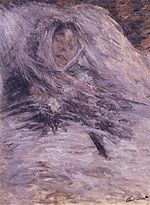
In 1875, he returned to figure painting with Woman with a Parasol - Madame Monet and Her Son, after effectively abandoning it with The Luncheon. His interest in the figure continued for the next four years—reaching its crest in 1877 and concluding altogether in 1890.[29][61] In an "unusually revealing" letter to Théodore Duret, Monet discussed his revitalised interest: "I am working like never before on a new endeavour figures in plein air, as I understand them. This is an old dream, one that has always obsessed me and that I would like to master once and for all. But it is all so difficult! I am working very hard, almost to the point of making myself ill".
In 1876, Camille Monet became seriously ill.[62] Their second son, Michel, was born in 1878, after which Camille's health deteriorated further.[62] In the autumn of that year, they moved to the village of Vétheuil where they shared a house with the family of Ernest Hoschedé, a wealthy department store owner and patron of the arts who had commissioned four paintings from Monet.[12][15] In 1878, Camille was diagnosed with uterine cancer.[63] She died the next year.[15] Her death, alongside financial difficulties—once having to leave his house to avoid creditors—afflicted Monet's career; Hoschedé had recently purchased several paintings but soon went bankrupt, leaving for Paris in hopes of regaining his fortune, as interest in the Impressionists dwindled.[16][12][15]

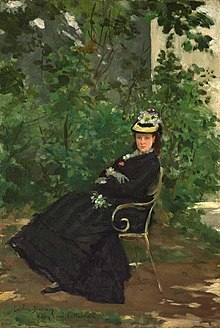
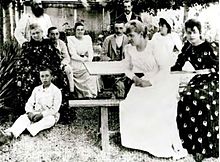
Monet made a study in oils of his late wife. Many years later, he confessed to his friend Georges Clemenceau that his need to analyse colours was both a joy and a torment to him. He explained: "I one day found myself looking at my beloved wife's dead face and just systematically noting the colours according to an automatic reflex".[64] John Berger describes the work as "a blizzard of white, grey, purplish paint ... a terrible blizzard of loss which will forever efface her features. In fact there can be very few death-bed paintings which have been so intensely felt or subjectively expressive."[65]
Monet's study of the Seine continued. He submitted two paintings to the Salon in 1880, one of which was accepted.[12] He began to abandon Impressionist techniques as his paintings utilised darker tones and displayed environments, such as the Seine River, in harsh weather. For the rest of the decade, he focused on the elemental aspect of nature.[24][53] His personal life influenced his distancing from the Impressionists.[15] He returned to Étretat and expressed in letters to Alice Hoschedé—who he would marry in 1892, following her husband's death the preceding year—a desire to die.[14][15][61] In 1881, he moved with Alice and her children to Poissy and again sold his paintings to Durand-Ruel.[12] Alice's third daughter, Suzanne, would become Monet's "preferred model", after Camille.[61]
In April 1883, looking out the window of the train between Vernon and Gasny, he discovered Giverny in Normandy.[66] That same year his first major retrospective show was held.[53]
In a letter sent to Monet in 1884, Paul Durand-Ruel mentions Monet's financial worries, and tells him that both the stockbroker Theodore-Charles Gadala and Georges Clemenceau have purchased paintings.[67] Monet's struggles with creditors ended following prosperous trips; he went to Bordighera in 1884, and brought back 50 landscapes.[12][53] He travelled to the Netherlands in 1886 to paint the tulips. He soon met and became friends with Gustave Geffroy, who published an article on Monet.[12] Despite his qualms, Monet's paintings were sold in America and contributed towards his financial security.[15] In contrast to the last two decades of his career, Monet favoured working alone—and felt that he was always better when he did, having regularly "long[ed] for solitude, away from crowded tourist resorts and sophisticated urban settings".[68][53] Such a desire was recurrent in his letters to Alice.[68][61]
- Paintings 1873–1886
-
Effet de Brouillard, c. 1872
-
Camille Monet on a Garden Bench, 1873, Metropolitan Museum of Art, New York
-
The Seine at Argenteuil, 1873
-
The Artist's House at Argenteuil, 1873, Art Institute of Chicago
-
Coquelicots, La promenade (Poppies), 1873, Musée d'Orsay, Paris
-
Argenteuil, 1874, National Gallery of Art, Washington D.C.
-
The Studio Boat, 1874, Kröller-Müller Museum, Otterlo, Netherlands
-
Camille au métier, 1875, Barnes collection
-
Woman with a Parasol - Madame Monet and Her Son, 1875, National Gallery of Art, Washington D.C.
-
Madame Monet in a Japanese Kimono, 1876, Museum of Fine Arts, Boston
-
Flowers on the Riverbank at Argenteuil, 1877, Pola Museum of Art, Japan
-
Vétheuil in the Fog, 1879, Musée Marmottan Monet, Paris
-
The Thaw at Vétheuil, 1880, Thyssen-Bornemisza Museum, Madrid
-
La Falaise à Fécamp, 1881, Aberdeen Art Gallery
-
Study of a Figure Outdoors: Woman with a Parasol, Facing Left, (Suzanne Hoschedé), 1886, Musée d'Orsay
Giverny
[edit]
In 1883, Monet and his family rented a house and gardens in Giverny, which provided him with domestic stability he had not yet enjoyed.[15] The house was situated near the main road between the towns of Vernon and Gasny at Giverny. There was a barn that doubled as a painting studio, orchards and a small garden. The house was close enough to the local schools for the children to attend, and the surrounding landscape provided numerous natural areas for Monet to paint.[69][70][71]
The family worked and built up the gardens, and Monet's fortunes began to change for the better as Durand-Ruel had increasing success in selling his paintings.[72] The gardens were Monet's greatest source of inspiration for 40 years.[73][74] In 1890, Monet purchased the house.[53] During the 1890s, Monet built a greenhouse and a second studio, a spacious building well lit with skylights.
Monet wrote daily instructions to his gardener, precise designs and layouts for plantings, and invoices for his floral purchases and his collection of botany books. As Monet's wealth grew, his garden evolved. He remained its architect, even after he hired seven gardeners.[75] Monet purchased additional land with a water meadow.[12] White water lilies local to France were planted along with imported cultivars from South America and Egypt, resulting in a range of colours including yellow, blue and white lilies that turned pink with age.[76] In 1902, he increased the size of his water garden by nearly 4000 square metres; the pond was enlarged in 1901 and 1910 with easels installed all around to allow different perspectives to be captured.[15][74]
Dissatisfied with the limitations of Impressionism, Monet began to work on series of paintings displaying single subjects—haystacks, poplars and the Rouen Cathedral—to resolve his frustration.[24][61] These series of paintings provided widespread critical and financial success; in 1898, 61 paintings were exhibited at the Petit Gallery.[77] He also began a series of Mornings on the Seine, which portrayed the dawn hours of the river.[15] In 1887 and 1889 he displayed a series of paintings of Belle Île to rave reviews by critics.[68] Monet chose the location in the hope of finding a "new aesthetic language that bypassed learned formulas, one that would be both true to nature and unique to him as an individual, not like anyone else."[68]

In 1899, he began painting the water lilies that would occupy him continuously for the next 20 years of his life, being his last and "most ambitious" sequence of paintings.[31][78] He had exhibited this first group of pictures of the garden, devoted primarily to his Japanese bridge, in 1900.[15] He returned to London—now residing at the prestigious Savoy Hotel—in 1899 to produce a series that included 41 paintings of Waterloo bridge, 34 of Charing Cross bridge and 19 of the House of Parliament.[79] Monet's final journey would be to Venice, with Alice in 1908.[15]
Depictions of the water lilies, with alternating light and mirror-like reflections, became an integral part of his work.[80] By the mid-1910s Monet had achieved "a completely new, fluid, and somewhat audacious style of painting in which the water-lily pond became the point of departure for an almost abstract art".[81] Claude Roger-Marx noted in a review of Monet's successful 1909 exhibition of the first Water Lilies series that he had "reached the ultimate degree of abstraction and imagination joined to the real".[82] This exhibition, entitled Waterlilies, a Series of Waterscape, consisted of 42 canvases, his "largest and most unified series to date".[15] He would ultimately make over 250 paintings of the Waterlilies.[50]
At his house, Monet met with artists, writers, intellectuals and politicians from France, England, Japan and the United States.[16] In the summer of 1887, he met John Singer Sargent whose experimentation with figure painting out of doors intrigued him; the pair went on to frequently influence each other.[61]
- Garden
-
In the Garden, 1895, Collection E. G. Buehrle, Zürich
-
Agapanthus, between 1914 and 1926, Museum of Modern Art, New York
-
Flowering Arches, Giverny, 1913, Phoenix Art Museum
-
Water Lilies and the Japanese Bridge, 1897–1899, Princeton University Art Museum
-
Water Lilies, 1906, Art Institute of Chicago
-
Water Lilies, Musée Marmottan Monet
-
Water Lilies, c. 1915, Neue Pinakothek, Munich
-
Water Lilies, c. 1915, Musée Marmottan Monet
Failing sight
[edit]Monet's second wife, Alice, died in 1911, and his oldest son, Jean, who had married Alice's daughter, Blanche, Monet's particular favourite, died in 1914.[83] Their deaths left Monet depressed, as Blanche cared for him.[15][84] It was during this time that Monet began to develop the first signs of possible cataracts.[84] In 1913, Monet travelled to London to consult the German ophthalmologist Richard Liebreich. He was prescribed new glasses and rejected cataract surgery for the right eye.[85] The next year, Monet, encouraged by Clemenceau, made plans to construct a new, large studio that he could use to create a "decorative cycle of paintings devoted to the water garden".[15]
In the following years, his perception of colour suffered; his broad strokes were broader and his paintings were increasingly darker. To achieve his desired outcome, he began to label his tubes of paint, kept a strict order on his palette and wore a straw hat to negate glare.[85] He approached painting by formulating the ideas and features in his mind, taking the "motif in large masses" and transcribing them through memory and imagination. This was due to him being "insensitive" to the "finer shades of tonalities and colors seen close up".[86]
Monet's output decreased as he became withdrawn, although he did produce several panel paintings for the French Government, from 1914 to 1918 to great financial success and he would later create works for the state.[85][74][82] His work on the "cycle of paintings" mostly occurred around 1916 to 1921.[15] Cataract surgery was once again recommended, this time by Clemenceau.[85] Monet—who was apprehensive, following Honoré Daumier and Mary Cassatt's botched surgeries—stated that he would rather have poor sight and perhaps abandon painting than forego "a little of these things that I love".[85] In 1919, Monet began a series of landscape paintings, "in full force" although he was not pleased with the outcome.[82] By October the weather caused Monet to cease plein air painting and the next month he sold four of the eleven Water Lilies paintings, despite his then-reluctance to relinquish his work.[82] The series inspired praise from his peers; his later works were well received by dealers and collectors, and he received 200,000 francs from one collector.[82]
In 1922 a prescription of mydriatics provided short-lived relief. He eventually underwent cataract surgery in 1923. Persistent cyanopsia and aphakic spectacles proved to be a struggle. Now "able to see the real colours", he began to destroy canvases from his pre-operative period.[85] Upon receiving tinted Zeiss lenses, Monet was laudatory, although his left eye soon had to be entirely covered by a black lens. By 1925, his visual impairment was improved and he began to retouch some of his pre-operative works, with bluer water lilies than before.[87][85]
During World War I, in which his younger son, Michel, served, Monet painted a Weeping Willow series as homage to the French fallen soldiers.[88] He became deeply dedicated to the decorations of his garden during the war.[74]
- Late paintings
-
Water Lilies and Reflections of a Willow (1916–1919), Musée Marmottan Monet
-
Water-Lily Pond and Weeping Willow, 1916–1919, Sale Christie's New York, 1998
-
Weeping Willow, 1918–19, Kimball Art Museum, Fort Worth, Monet's Weeping Willow paintings were an homage to the fallen French soldiers of World War I
-
House Among the Roses, between 1917 and 1919, Albertina, Vienna
-
The Rose Walk, Giverny, 1920–1922, Musée Marmottan Monet
-
The Japanese Footbridge, 1920–1922, Museum of Modern Art
-
Wisteria, 1920–1925, Kunstmuseum Den Haag
Method
[edit]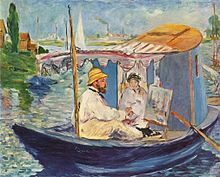
Monet has been described as "the driving force behind Impressionism".[89] Crucial to the art of the Impressionist painters was the understanding of the effects of light on the local colour of objects, and the effects of the juxtaposition of colours with each other.[90] His free flowing style and use of colour have been described as "almost ethereal" and the "[epitome] of impressionist style"; Impression, Sunrise is an example of the "fundamental" Impressionist principle of depicting only that which is purely visible.[24][91] Monet was fascinated with the effects of light, and painting en plein air—he believed that his only "merit lies in having painted directly in front of nature, seeking to render my impressions of the most fleeting effects"[14][91] Wanting to "paint the air", he often combined modern life subjects in outdoor light.[27][92]

Monet made light the central focus of his paintings. To capture its variations, he would sometimes complete a painting in one sitting, often without preparation.[93] He wished to demonstrate how light altered colour and perception of reality.[24] His interest in light and reflection began in the late 1860s and lasted throughout his career.[21] During his first time in London, he developed an admiration for the relationship between the artist and motifs—for what he deemed the "envelope".[79] He utilised pencil drawings to quickly note subjects and motifs for future reference.[15]
Monet's portrayal of landscapes emphasised industrial elements such as railways and factories; his early seascapes featured brooding nature depicted with muted colours and local residents.[28][43] Critic, and friend of Monet, Théodore Duret noted, in 1874, that he was "little attracted by rustic scenes...He [felt] particularly drawn towards nature when it is embellished and towards urban scenes and for preference he paint[ed] flowery gardens, parks and groves."[31] When depicting figures and landscapes in tandem, Monet wished for the landscape to not be a mere backdrop and the figures not to dominate the composition.[61] His dedication to such a portrayal of landscapes resulted in Monet reprimanding Renoir for defying it.[61] He often depicted the suburban and rural leisure activities of Paris and as a young artist experimented with still lifes.[21][43] From the 1870s onwards, he gradually moved away from suburban and urban landscapes—when they were depicted it was to further his study of light.[50] Contemporary critics—and later academics—felt that with his choice of showcasing Belle Île, he had indicated a desire to move away from the modern culture of Impressionist paintings and instead towards primitive nature.[68]
After meeting Boudin, Monet dedicated himself to searching for new and improved methods of painterly expression. To this end, as a young man, he visited the Salon and familiarised himself with the works of older painters, and made friends with other young artists.[89] The five years that he spent at Argenteuil, spending much time on the River Seine in a little floating studio, were formative in his study of the effects of light and reflections. He began to think in terms of colours and shapes rather than scenes and objects. He used bright colours in dabs and dashes and squiggles of paint. Having rejected the academic teachings of Gleyre's studio, he freed himself from theory, saying "I like to paint as a bird sings."[94] Boudin, Daubigny, Jongkind, Courbet, and Corot were among Monet's influences and he would often work in accordance with developments in avant-garde art.[22][14][61][95]
In 1877 a series of paintings at St-Lazare Station had Monet looking at smoke and steam and the way that they affected colour and visibility, being sometimes opaque and sometimes translucent. He was to further use this study in the painting of the effects of mist and rain on the landscape.[96] The study of the effects of atmosphere was to evolve into a number of series of paintings in which Monet repeatedly painted the same subject (such as his water lilies series)[97] in different lights, at different hours of the day, and through the changes of weather and season. This process began in the 1880s and continued until the end of his life in 1926.[citation needed] In his later career, Monet "transcended" the Impressionist style and begun to push the boundaries of art.[24][98]

Monet refined his palette in the 1870s, consciously minimising the use of darker tones and favouring pastel colours. This coincided with his softer approach, using smaller and more varied brush strokes. His palette would again undergo change in the 1880s, with more emphasis than before on harmony between warm and cold hues.[15] Following his optical operation in 1923, Monet returned to his style from before a decade ago. He forwent garish colours or "coarse application" for emphasised colour schemes of blue and green.[85] Whilst suffering from cataracts, his paintings were more broad and abstract—from the late 1880s onwards, he had simplified his compositions and sought subjects that could offer broad colour and tone.[85][99] He increasingly used red and yellow tones, a trend that first started following his trip to Venice.[91] Monet often travelled alone at this time—from France to Normandy to London; to the Rivera and Rouen—in search of new and more challenging subjects.[16][100]

The stylistic change was likely a by-product of the disorder and not an intentional choice.[85] Monet would often work on large canvases due to the deterioration of his eyesight and by 1920 he admitted that he had grown too accustomed to broad painting to return to small canvases.[24][82] The influence of his cataracts on his output has been a topic of discussion among academics; Lane et al. (1997) argues the occurrence of a deterioration from the late 1860s onwards led to a diminishing of sharp lines.[91] Gardens were a focus throughout his art, becoming prominent in his later work, especially during the last decade of his life.[31][74] Daniel Wildenstein noted a "seamless" continuity in his paintings that was "enriched by innovation".[100]

From the 1880s onwards—and particularly in the 1890s—Monet's series of paintings of specific subjects sought to document the different conditions of light and weather.[15] As light and weather changed throughout the day, he switched between canvases—sometimes working on as many as eight at one time—usually spending an hour on each.[15] In 1895, he exhibited 20 paintings of Rouen Cathedral, showcasing the façade in different conditions of light, weather and atmosphere.[15] The paintings do not focus on the grand Medieval building, but on the play of light and shade across its surface, transforming the solid masonry.[101] For this series, he experimented with creating his own frames.[102]
His first series exhibited was of haystacks, painted from different points of view and at different times of the day. Fifteen of the paintings were exhibited at the Galerie Durand-Ruel in 1891. In 1892 he produced twenty-six views of Rouen Cathedral.[90] Between 1883 and 1908, Monet travelled to the Mediterranean, where he painted landmarks, landscapes, and seascapes, including a series of paintings in Venice. In London he painted four series: the Houses of Parliament, London, Charing Cross Bridge, Waterloo Bridge, and Views of Westminster Bridge. Helen Gardner writes:
Monet, with a scientific precision, has given us an unparalleled and unexcelled record of the passing of time as seen in the movement of light over identical forms.[103]
- Series of paintings
-
La Gare Saint-Lazare, 1877, Musée d'Orsay
-
Arrival of the Normandy Train, Gare Saint-Lazare, 1877, The Art Institute of Chicago,[104] a part of Monet's Gare Saint-Lazare series.
-
The Cliffs at Etretat, 1885, Clark Art Institute
-
Sailboats behind the needle at Etretat, 1885
-
The Pyramides at Port-Coton, Sun Effect, 1886, Private collection
-
Two paintings from a series of grainstacks, 1890–91: Grainstacks in the Sunlight, Morning Effect
-
Grainstacks, end of day, Autumn, 1890–1891, Art Institute of Chicago
-
Falaise a Pourville soleil levant, 1897, Magnani-Rocca Foundation
-
Falaise a Pourville soleil levant, 1897, private collection
-
Poplars at the River Epte, 1891 Tate, London
-
Rouen Cathedral at sunset, 1893, Musée Marmottan Monet
-
Rouen Cathedral, Morning Light, 1894, J. Paul Getty Museum
-
The Seine Near Giverny, 1897, Museum of Fine Arts, Boston
-
Morning on the Seine, 1898, National Museum of Western Art, Tokyo
-
Charing Cross Bridge, 1899, Thyssen-Bornemisza Museum, Madrid
-
Charing Cross Bridge, London, 1899–1901, Saint Louis Art Museum
-
Two paintings from a series of The Houses of Parliament, London, 1900–01, Art Institute of Chicago
-
London, Houses of Parliament. The Sun Shining through the Fog, 1904, Musée d'Orsay
-
Grand Canal, Venice, 1908, Museum of Fine Arts, Boston
-
Grand Canal, Venice, 1908, Fine Arts Museums of San Francisco
Water lilies
[edit]Following his return from London, Monet painted mostly from nature, in his own garden; its water lilies, its pond and its bridge. From 22 November to 15 December 1900, another exhibition dedicated to him was held at the Durand-Ruel gallery, with around ten versions of the Water Lilies exhibited. This same exhibition was organized in February 1901 in New York City, where it was met with great success.[34]
In 1901, Monet enlarged the pond of his home by buying a meadow located on the other side of the Ru, the local watercourse. He then divided his time between work on nature and work in his studio.[105]
The canvases dedicated to the water lilies evolved with the changes made to his garden. In addition, around 1905, Monet gradually modified his aesthetics by abandoning the perimeter of the body of water and therefore modifying his perspective. He also changed the shape and size of his canvases by moving from rectangular stretchers to square and then circular stretchers.[34]
These canvases were created with great difficulty: Monet spent a significant amount of time reworking them in order to find the perfect effects and impressions. When he deemed them unsuccessful he did not hesitate to destroy them. He continually postponed the Durand-Ruel exhibition until he was satisfied with the works. After several postponements dating back to 1906, the exhibition titled Les Nymphéas ended up opening on 6 May 1909. Comprising forty-eight paintings dating from 1903 to 1908, representing a series of landscapes and water lily scenes, this exhibition was once again a success.[34]
- Water lilies
-
Le Bassin Aux Nymphéas, 1919. Monet's late series of water lily paintings are among his best-known works.
-
Water Lilies, 1919, Metropolitan Museum of Art, New York
-
Water Lilies, 1917–1919, Honolulu Museum of Art
-
Water Lilies, 1920, National Gallery, London
-
Water Lilies, c. 1915–1926, Nelson-Atkins Museum of Art, Kansas City, Missouri
-
Reflections of Clouds on the Water-Lily Pond, c. 1920, Museum of Modern Art, New York
Death
[edit]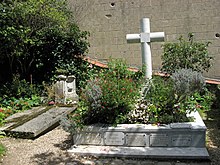
Monet died of lung cancer on 5 December 1926 at the age of 86 and is buried in the Giverny church cemetery. Monet had insisted that the occasion be simple; thus, only about fifty people attended the ceremony.[106] At his funeral, Clemenceau removed the black cloth draped over the coffin, stating: "No black for Monet!" and replaced it with a flower-patterned cloth.[107] At the time of his death, Waterlilies was "technically unfinished".[50]
Monet's home, garden, and water lily pond were bequeathed by Michel to the French Academy of Fine Arts (part of the Institut de France) in 1966. Through the Fondation Claude Monet, the house and gardens were opened for visits in 1980, following restoration.[108] In addition to souvenirs of Monet and other objects of his life, the house contains his collection of Japanese woodcut prints, which had a pronounced influence on his art.[109] The house and garden, along with the Museum of Impressionism, are major attractions in Giverny, which hosts tourists from all over the world.
Legacy
[edit]Speaking of Monet's body of work, Wildenstein said that it is "so extensive that its very ambition and diversity challenges our understanding of its importance".[100] His paintings produced at Giverny and under the influence of cataracts have been said to create a link between Impressionism and twentieth-century art and modern abstract art, respectively.[85][100] His later works were a "major" inspiration to Objective abstraction.[110] Ellsworth Kelly, following a formative experience at Giverny, paid homage to Monet's works created there with Tableau Vert (1952).[98] Monet has been called an "intermediary" between tradition and modernism—his work has been examined in relation to postmodernism and influenced Bazille, Sisley, Renoir, and Pissarro.[21][98] Monet is now the most famous of the Impressionists; as a result of his contributions to the movement, he "exerted a huge influence on late 19th-century art".[16][111]

In May 1927, 27 panel paintings were displayed in the Musée de l'Orangerie, following lengthy negotiations with the French government.[82] Because his later works were ignored by artists, art historians, critics, and the public, few attended the showing.[98] In the 1950s, Monet's later works were "rediscovered" by the Abstract Expressionists, who used similar canvases[clarification needed] and were uninterested in the blunt and ideological art of the war.[98][24] A 1952 essay by André Masson helped change the perception of the paintings and inspired an appreciation that began to take shape in 1956–1957.[98] The next year, a fire in the Museum of Modern Art would see the Water Lilies paintings it had acquired burn.[98] The large-scale nature of Monet's later paintings proved to be difficult for some museums, which resulted in their altering the framing.[98]
In 1978, Monet's garden in Giverny—which had grown decrepit over fifty years—was restored and opened to the public.[73] In 2004, London, the Parliament, Effects of Sun in the Fog (Londres, le Parlement, trouée de soleil dans le brouillard; 1904), sold for US$20.1 million.[112] In 2006, the journal Proceedings of the Royal Society published a paper providing evidence that these were painted in situ at St. Thomas' Hospital over the river Thames.[113][114] In 1981, Ronald Pickvance noted that Monet's works after 1880 were increasingly receiving scholarly attention.[115]
Falaises près de Dieppe (Cliffs Near Dieppe) has been stolen on two occasions, once in 1998 (in which the museum's curator was convicted of the theft and jailed for five years and two months, along with two accomplices) and again in August 2007.[116] It was recovered in June 2008.[117]
On 14 November 2001, a Google Doodle was made for Claude Monet's 161st birthday, depicting the Google logo in Monet's signature style.[118] It was the first Google Doodle made for someone's birthday.
Monet's Le Pont du chemin de fer à Argenteuil, an 1873 painting of a railway bridge spanning the Seine near Paris, was bought by an anonymous telephone bidder for a record $41.4 million at Christie's auction in New York on 6 May 2008. The previous record for a Monet painting stood at $36.5 million.[119] A few weeks later, Le bassin aux nymphéas (from the water lilies series) sold at Christie's 24 June 2008 auction in London[120] for £40,921,250 ($80,451,178), nearly doubling the record for the artist.[121] This purchase represented one of the top 20 highest prices paid for a painting at the time.
In October 2013, Monet's paintings L'Eglise de Vétheuil and Le Bassin aux Nympheas became subjects of a legal case in New York against New York-based Vilma Bautista, one-time aide to Imelda Marcos, wife of dictator Ferdinand Marcos,[122] after she sold Le Bassin aux Nympheas for $32 million to a Swiss buyer. The said Monet paintings, along with two others, were acquired by Imelda during her husband's presidency and allegedly bought using the nation's funds. Bautista's lawyer claimed that the aide sold the painting for Imelda but did not have a chance to give her the money. The Philippine government seeks the return of the painting.[122] Le Bassin aux Nympheas, also known as Japanese Footbridge over the Water-Lily Pond at Giverny, is part of Monet's famed Water Lilies series.
A sympathetic portrait of Claude Monet can be found in R. W. Meek's historical fiction novels The Dream Collector, Book I[123] and Book II.[124] Monet's documented attack of hysterical blindness is reimagined and cured through hypnosis by the dream collector, Julie Forette.
Nazi looting
[edit]Under the Nazi regime, both in Germany from 1933 and in German-occupied countries until 1945, Jewish art collectors of Monet were robbed by Nazis and their agents. Several of the stolen artworks have been returned to their rightful owners, while others have been the object of court battles. In 2014, during the spectacular discovery of a hidden trove of art in Munich, a Monet that had belonged to a Jewish retail magnate was found in the suitcase of Cornelius Gurlitt, the son of one of Hitler's official dealers of looted art, Hildebrand Gurlitt.[125][126]
Examples of Nazi-looted Monet works include:
- Bord de Mer, purchased by Austrians Adalbert and Hilda Parlagi in 1936. After the Anschluss, they fled in 1938, leaving it in a Vienna warehouse. It resurfaced in France in 2016 and was restored to the Parlagis' granddaughters in 2024.[127]
- Haystacks at Giverny belonged to René Gimpel, a French Jewish art dealer killed in a Nazi concentration camp.[128][129]
- Nymphéas, stolen by Nazis in 1940 from Paul Rosenberg.[130]
- Au Parc Monceau, previously owned by Ludwig Kainer, whose vast collection was looted by the Nazis.[131]
- Le Repos Dans Le Jardin Argenteuil, previously owned by Henry and Maria Newman, stolen from a Berlin bank vault, settlement with the Metropolitan Museum of Art.[132]
- La Seine à Asnières/Les Péniches sur la Seine, formerly owned by Mrs. Fernand Halphen, taken by agents of the German Embassy in Paris on 10 July 1940.[133]
Monet's Le Palais Ducal, and his 1880 work, Poppy Field near Vétheuil, formerly in the collection of Max Emden, have been the object of restitution claims.[134][135] "La Mare, Snow Effect" ("La Mare, effect de neige") was the object of a settlement with the heirs of Richard Semmel.[136]
See also
[edit]Footnotes
[edit]- ^ Khan et al. 2010 conversely describes the exile as forceful.
References
[edit]- ^ Auricchio 2004.
- ^ House, John, et al.: Monet in the 20th century, page 2, Yale University Press, 1998.
- ^ a b P. Tucker Claude Monet: Life and Art, p. 5
- ^ Patin, Sylvie. "Monet: un œil... mais, bon Dieu, quel œil!" Découvertes Gallimard, Number 131, série Arts. p. 14
- ^ Levine 1994, chapter 6.
- ^ Butler 2008.
- ^ {{|title=The New Encyclopaedia Britannica|date=1 January 1974|publisher=Encyclopaedia Britannica|isbn=978-0-85229-290-7|page=347|language=en}}
- ^ Tinterow & Loyrette 1994, pp. 417.
- ^ "Claude Monet Biography". biography.com. Archived from the original on 9 February 2017. Retrieved 7 February 2017.
- ^ Arnold, Matthias (2005). Claude Monet. London: H Books. p. 3. ISBN 9781904950004.
- ^ a b Fourny-Dargère, Sophie, and Claude Monet (1992). Monet. New York: Konecky and Konecky. p. 30. ISBN 9781568522487.
- ^ a b c d e f g h i j k l m n o p q r s t Oxford Art (31 October 2011). "Monet, Claude". Oxford Art Online. doi:10.1093/benz/9780199773787.article.B00124536. ISBN 978-0-19-989991-3. Retrieved 24 May 2021.
- ^ a b c d Greenberg, Susan D. (2001). "The Face of Impressionism in 1870: Claude Monet's "Camille on the Beach at Trouville"". Yale University Art Gallery Bulletin: 66–73. ISSN 0084-3539. JSTOR 40514596. Archived from the original on 2 June 2021. Retrieved 1 June 2021.
- ^ a b c d e f g Levine 1986, pp. 65–75.
- ^ a b c d e f g h i j k l m n o p q r s t u v w x y z aa ab ac ad ae af ag ah ai aj Isaacon, Joel (2003). "Monet, (Oscar-)Claude". Oxford Art Online. doi:10.1093/gao/9781884446054.article.T059077. ISBN 9781884446054.
- ^ a b c d e f g h Brettell, Hayes Tucker & Henderson Lee 2009, pp. 63.
- ^ Januszczak 1985, p. 304.
- ^ House, John (1986). Monet: Nature Into Art Archived 17 April 2023 at the Wayback Machine. New Haven, Conn: Yale University Press. p. 5. ISBN 9780300043617.
- ^ Jeffrey Meyers, "Monet in Algeria", pp 19–24 "History Today" April 2015
- ^ "Musée d'Orsay: non_traduit". www.musee-orsay.fr. Archived from the original on 31 July 2020. Retrieved 2 February 2021.
- ^ a b c d e f g Tinterow & Loyrette 1994, p. 418.
- ^ a b c Januszczak 1985, p. 154.
- ^ Tinterow & Loyrette 1994, p. 420.
- ^ a b c d e f g h i Weidemann, Christiane (2017). 50 Modern Artists You Should Know. Prestel Publishing. p. 20. ISBN 9783791383385.
- ^ Tinterow & Loyrette 1994, p. 419.
- ^ Distel et al. 1974, p. 131.
- ^ a b Januszczak 1985, p. 126.
- ^ a b c d e f Groom, Gloria; Shaw, Jill (2014), "The Beach at Sainte-Adresse", The Beach at Sainte-Adresse from Monet Paintings and Drawings at the Art Institute of Chicago, Art Institute of Chicago, pp. 1–6, ISBN 978-0-86559-269-8, JSTOR j.ctt1vjqpmr.1, archived from the original on 2 June 2021, retrieved 2 June 2021
- ^ a b c Wagner, Anne M. (1994). "Why Monet Gave up Figure Painting". The Art Bulletin. 76 (4): 613–629. doi:10.2307/3046059. ISSN 0004-3079. JSTOR 3046059. Archived from the original on 6 June 2021. Retrieved 6 June 2021.
- ^ "What Did This $1.4M Painting Have To Do With Monet's Suicide Attempt?". HuffPost. 2 August 2012. Archived from the original on 23 January 2023.
{{cite web}}: Unknown parameter|No access-date=ignored (help) - ^ a b c d e f g House, John (2003). "Monet's "Gladioli"". Bulletin of the Detroit Institute of Arts. 77 (1/2): 8–17. doi:10.1086/DIA23183126. ISSN 0011-9636. JSTOR 23183126. S2CID 189077027. Archived from the original on 22 May 2021. Retrieved 22 May 2021.
- ^ a b Charles Stuckey "Monet, a Retrospective", Hugh Lauter Levin Associates, 195
- ^ "Henry Bellet, Les Impressionnistes, ces peintres français tapis dans Londres, 13 July 2018". Le Monde.fr. 13 July 2018. Archived from the original on 2 June 2021. Retrieved 2 June 2021.
- ^ a b c d Dominique Lobstein, Monet, Éditions Jean-Paul Gisserot, 2002, pp. 38, 106-107
- ^ The texts of seven police reports, written on 2 June – 9 October 1871 are included in Monet in Holland, the catalog of an exhibition in the Amsterdam Van Gogh Museum (1986).
- ^ Brettell, Hayes Tucker & Henderson Lee 2009, pp. 66.
- ^ a b Bailey, Rishel & Rosenthal 1989, pp. 52.
- ^ Bailey, Rishel & Rosenthal 1989, pp. 46–48.
- ^ Poulet, Anne L.; Murphy, Alexandra R. (1979). Corot to Braque: French Paintings from the Museum of Fine Arts, Boston. Boston: The Museum. p. 92. ISBN 0-87846-134-5.
- ^ Fourny-Dargère, Sophie, and Claude Monet (1992). Monet. New York: Konecky and Konecky. pp. 58, 64. ISBN 9781568522487.
- ^ Charles F. Stuckey, pp. 11–16
- ^ Haine, Scott (2000). The History of France (1st ed.). Greenwood Press. p. 112. ISBN 978-0-313-30328-9.
- ^ a b c d e Samu, Margret (October 2004). "Impressionism: Art and Modernity". Metropolitan Museum of Art. Archived from the original on 13 October 2004. Retrieved 26 May 2021.
- ^ Brodskaya, Nathalia (1 July 2011). Claude Monet. Parkstone International. ISBN 9781780422978. Archived from the original on 17 April 2023. Retrieved 29 May 2021 – via Google Books.
- ^ a b Bernard Denvir, The Chronicle of Impressionism: A Timeline History of Impressionist Art, Bulfinch Press Book, 1993
- ^ a b Bernard Denvir, The chronicle of impressionism: an intimate diary of the lives and world of the great artists Archived 17 April 2023 at the Wayback Machine, Thames & Hudson, Limited, 1993
- ^ a b "The First Impressionist Exhibition, 1874 – Notes". artchive.com. Archived from the original on 10 January 2014. Retrieved 10 January 2014.
- ^ Januszczak 1985, p. 192.
- ^ a b Dombrowski, André (2 April 2020). "Impressionism and the Standardization of Time: Claude Monet at Gare Saint-Lazare". The Art Bulletin. 102 (2): 91–120. doi:10.1080/00043079.2020.1676129. ISSN 0004-3079. S2CID 219796908. Archived from the original on 5 June 2021. Retrieved 5 June 2021.
- ^ a b c d Brigstocke, Hugh (2001). "Monet, Claude". The Oxford Companion to Western Art. Oxford University Press. ISBN 9780198662037.
- ^ Januszczak 1985, p. 276.
- ^ Januszczak 1985, p. 158.
- ^ a b c d e f Januszczak 1985, p. 258.
- ^ "Search the Collection » Norton Simon Museum". nortonsimon.org. Archived from the original on 20 December 2013. Retrieved 18 December 2013.
- ^ "Musée d'Orsay: Claude Monet Women in the Garden". musee-orsay.fr. Archived from the original on 14 January 2015. Retrieved 18 December 2013.
- ^ "Claude Monet – Garden at Sainte-Adresse". Metropolitan Museum of Art. Archived from the original on 30 January 2022. Retrieved 11 April 2018.
- ^ "Das Städel Museum – Kunstmuseum in Frankfurt". Städel Museum. Archived from the original on 24 December 2013. Retrieved 21 December 2013.
- ^ "Claude Monet – La Grenouillère". Metropolitan Museum of Art. Archived from the original on 24 January 2022. Retrieved 11 April 2018.
- ^ "Artwork". Museum of Fine Arts, Budapest. Archived from the original on 8 January 2015. Retrieved 22 December 2013.
- ^ London, The National Gallery. "Claude Monet - The Beach at Trouville - NG3951 - National Gallery, London". nationalgallery.org.uk. Archived from the original on 24 December 2013. Retrieved 22 December 2013.
- ^ a b c d e f g h i Bailey, Rishel & Rosenthal 1989, pp. 54.
- ^ a b Milner, Frank (1991) Monet. New York: Mallard Press. p. 16. ISBN 9780792455066.
- ^ Jiminez, Jill Berk (2013). Dictionary of Artists' Models. Routledge. p. 165. ISBN 1-135-95914-5.
- ^ Berger (1985), p. 194
- ^ Berger, John (1985). The Eyes of Claude Monet from Sense of Sight. New York: Pantheon Books. pp. 194–195. ISBN 978-0-679-73722-3.
- ^ Charles Merrill Mount. Monet, a biography, Simon & Schuster, 1966. p. 326.
- ^ Paul Durand-Ruel, "Letter to Claude Monet", Correspondence with Claude Monet, May–November 1884, accessed March 29, 2024.
- ^ a b c d e Athanassoglou-Kallmyer, Nina (3 July 2015). "Le Grand Tout: Monet on Belle-Île and the Impulse toward Unity". The Art Bulletin. 97 (3): 323–341. doi:10.1080/00043079.2015.1023158. ISSN 0004-3079. S2CID 193179280. Archived from the original on 5 June 2021. Retrieved 5 June 2021.
- ^ Goetz, Adrien (2015). Monet at Giverny. Claude Monet, Éric Sander. Montreuil. ISBN 978-2-35340-217-5. OCLC 920833948.
{{cite book}}: CS1 maint: location missing publisher (link) - ^ Je Bradley, Alexander (6 October 2016). The Gardens and House of Claude Monet. United States: Blurb, Incorporated. ISBN 9781367106147.
- ^ Monet, Claude (2004). Monet's garden. Christoph Becker, Kunsthaus Zürich ([English ed.] ed.). Ostfildern-Ruit, Germany: Hatje Cantz. ISBN 3-7757-1439-1. OCLC 56966754.
- ^ Mathews Gedo, Mary. Monet and His Muse: Camille Monet in the Artist's Life. University of Chicago Press, 2010. ISBN 978-0-226-28480-4
- ^ a b Wildenstein, Daniel (1978). Monet's Years at Giverny: Beyond Impressionism. Abrams Books. ISBN 9780810913363.
- ^ a b c d e Bailey, Rishel & Rosenthal 1989, pp. 57.
- ^ Garrett, Robert (20 May 2007). "Monet's gardens a draw to Giverny and to his art". Globe Correspondents. Archived from the original on 2 February 2009. Retrieved 13 October 2008.
- ^ Art Gallery of Victoria, Monet's Garden Archived 16 December 2013 at the Wayback Machine, (retrieved 16 December 2013)
- ^ Januszczak 1985, p. 270, 306.
- ^ "Water Lilies 1919". Metropolitan Museum of Art. Archived from the original on 30 January 2022. Retrieved 6 June 2021.
- ^ a b Khan, Soraya; Thornes, John E; Baker, Jacob; Olson, Donald W; Doescher, Russell L (2010). "Monet at the Savoy". Area. 42 (2): 208–216. Bibcode:2010Area...42..208K. doi:10.1111/j.1475-4762.2009.00913.x. ISSN 0004-0894. JSTOR 27801462. Archived from the original on 3 June 2021. Retrieved 2 June 2021.
- ^ Muir, Kim; Sutherland, Ken. "Color, Chemistry, and Creativity in Monet's Water Lilies Archived 6 June 2021 at the Wayback Machine". Art Institute of Chicago, 9 February 2021. Retrieved 6 June 2021
- ^ "Water Lilies Archived 15 December 2013 at the Wayback Machine". Metropolitan Museum of Art. Retrieved 6 June 2021
- ^ a b c d e f g Bailey, Rishel & Rosenthal 1989, pp. 58.
- ^ Biography for Claude Monet Archived 20 January 2007 at the Wayback Machine Guggenheim Collection. Retrieved 6 January 2007.
- ^ a b Forge, Andrew, and Gordon, Robert, Monet, page 224. Harry N. Abrams, 1989.
- ^ a b c d e f g h i j k Gruener, Anna (1 May 2015). "The effect of cataracts and cataract surgery on Claude Monet". British Journal of General Practice. 65 (634): 254–255. doi:10.3399/bjgp15X684949. ISSN 0960-1643. PMC 4408507. PMID 25918321.
- ^ Bailey, Rishel & Rosenthal 1989, p. 84.
- ^ Let the light shine in Archived 25 July 2008 at the Wayback Machine Guardian News, 30 May 2002. Retrieved 6 January 2007.
- ^ "Kimbell Art Museum, Weeping Willows". Archived from the original on 3 June 2021. Retrieved 29 May 2021.
- ^ a b Jennings, Guy (1986). Impressionist Painters. Octopus Books. ISBN 978-0-7064-2660-1.
- ^ a b Gardner, Helen (1995). Art through the Ages (10th Reiss ed.). Harcourt College Pub. p. 669. ISBN 978-0-15-501141-0.
- ^ a b c d Lane, Russell; Carey, Nessay; Orrell, Richard; Moxley, Richard T. (8 March 1997). "Claude Monet's vision". The Lancet. 349 (9053): 734. doi:10.1016/S0140-6736(05)60177-8. ISSN 0140-6736. PMID 9078229. S2CID 12528818.
- ^ Rollins, Mark (2004). "What Monet Meant: Intention and Attention in Understanding Art". The Journal of Aesthetics and Art Criticism. 62 (2): 175–188. doi:10.1111/j.1540-594X.2004.00150.x. ISSN 0021-8529. JSTOR 1559201.
- ^ Perkins 2013, p. 73, 88.
- ^ Jennings, p. 130
- ^ Brettell, Hayes Tucker & Henderson Lee 2009, pp. 65.
- ^ Jennings (1986), p. 132
- ^ "Claude Monet". Solomon R. Guggenheim Museum. Archived from the original on 23 April 2021. Retrieved 6 June 2021.
- ^ a b c d e f g h Easton 2009, pp. 866–867.
- ^ Wildenstein 1978, p. 12.
- ^ a b c d Wildenstein 1978, p. 11.
- ^ Jennings p. 137
- ^ Perkins 2013, pp. 35.
- ^ Gardner, Helen. Art through the Ages. p. 669
- ^ "Arrival of the Normandy Train, Gare Saint-Lazare – The Art Institute of Chicago". artic.edu. 1877. Archived from the original on 5 November 2013. Retrieved 15 December 2013.
- ^ Daniel Wildenstein, Monet ou le Triomphe de l'Impressionnisme, Cologne, Taschen, 1996, p. 362
- ^ P. Tucker Claude Monet: Life and Art, p. 224
- ^ McAuliffe, Mary (2011). Dawn of the Belle Epoque: The Paris of Monet, Zola, Bernhardt, Eiffel, Debussy, Clemenceau, and Their Friends (Paperback). Canberra: Rowman & Littlefield. pp. 338. ISBN 978-1-4422-0928-2.
- ^ "Historical record". Fondation-monet.fr. Archived from the original on 20 July 2011. Retrieved 19 January 2010.
- ^ Morelli, Vivian (28 February 2024). "Reviving a Japanese art form". The New York Times.
- ^ Bohm-Duchen, Monica (2003). "Objective Abstraction". Oxford Art Online. doi:10.1093/gao/9781884446054.article.T063148. Archived from the original on 17 April 2023. Retrieved 3 June 2021.
- ^ Chilvers, Ian; Glaves-Smith, John (2009). "Monet, Claude". A Dictionary of Modern and Contemporary Art (2nd ed.). Oxford University Press. ISBN 9780199239665.
- ^ "Monet's masterpiece reaches record high bid" Archived 17 December 2006 at the Wayback Machine newsfromrussia.com, 5 November 2004. Retrieved 6 January 2007.
- ^ "Virtual Monet Thumbnails Pg 1 | Special reports". The Guardian. Retrieved 5 June 2012.
- ^ Grovier, Kelly (21 October 2024). "'A mesmerising mirage': How Monet's paintings changed the way we see London". BBC. Retrieved 22 October 2024.
- ^ Pickvance, Ronald (1981). "Paris. Monet Symposium". The Burlington Magazine. 123 (945): 760. ISSN 0007-6287. JSTOR 880522. Archived from the original on 6 June 2021. Retrieved 6 June 2021.
- ^ "Monet and Others Stolen in Museum Heist in Nice". artforum.com. 8 August 2007. Archived from the original on 21 August 2007. Retrieved 8 August 2007.
- ^ "French police recover stolen Monet painting". artforum.com. 1 October 2009. Archived from the original on 30 September 2020. Retrieved 1 October 2009.
- ^ "Claude Monet's 161st Birthday". Google. Archived from the original on 3 January 2023. Retrieved 2 January 2023.
- ^ Vogel, Carol (6 May 2008). "Record Price for Monet at Auction". The New York Times. New York Times. Archived from the original on 2 December 2016. Retrieved 19 January 2010.
- ^ "Le Bassin Aux Nymphéas". Christies of London. 24 June 2008. Archived from the original on 13 January 2009. Retrieved 24 June 2008.
- ^ "Monet work auctioned for £40.9m". BBC News. 24 June 2008. Archived from the original on 11 October 2008. Retrieved 24 June 2008.
- ^ a b Ex-Imelda Marcos aide on trial in NYC for selling Monet work Archived 17 October 2013 at the Wayback Machine. Associated Press. 17 October 2013. Retrieved 17 October 2013.
- ^ Meek, R. w. (2023). The Dream Collector, Book I Sabrine & Sigmund Freud. NY, NY: Historium Press. ISBN 978-1-962465-13-7.
- ^ Meek, R. w. (2024). The Dream Collector, Book II Sabrine & Vincent van Gogh. NY, NY: Historium Press. ISBN 978-1-962465-34-2.
- ^ "Cornelius Gurlitt: Monet found in art hoarder's suitcase". BBC News. 5 September 2014. Archived from the original on 10 February 2021. Retrieved 8 February 2021.
- ^ "Monet Landscape Found in Gurlitt's Suitcase". Artnet. 5 September 2014. Archived from the original on 28 January 2021. Retrieved 8 February 2021.
- ^ Rabinowitz, Hannah (9 October 2024). "Rare Monet returned to family more than 80 years after it was stolen by Nazis". CNN. Retrieved 9 October 2024.
- ^ "Heirs of Holocaust victim to get compensation from sale of looted Monet". Haaretz. Archived from the original on 11 February 2021. Retrieved 8 February 2021.
- ^ JTA. "Heirs to get share of looted Monet sale". www.timesofisrael.com. Archived from the original on 15 February 2021. Retrieved 8 February 2021.
- ^ "Art - Le tableau de Monet attendait depuis 50 ans Le Nymphéas était là ...(photo)". L'Orient-Le Jour. 4 May 1999. Archived from the original on 19 July 2021. Retrieved 8 February 2021.
- ^ "Plainte d'une famille juive contre UBS pour des oeuvres d'art pillées par les nazis". Le Temps (in French). 18 October 2014. ISSN 1423-3967. Archived from the original on 14 February 2021. Retrieved 8 February 2021.
- ^ "Met To Sell Monet". archive.today. 7 February 2020. Archived from the original on 7 February 2020. Retrieved 8 February 2021.
- ^ "Cultural Plunder by the Einsatzstab Reichsleiter Rosenberg: Database of Art Objects at the Jeu de Paume: Owner: Fernand Halphen — Paris, France". Archived from the original on 14 June 2018.
- ^ D'Arcy, David (8 July 2020). "Heirs battle estate over $30m Monet painting from Emden collection sold during Nazi era". The Art Newspaper - International art news and events. Retrieved 30 June 2023.
The dispute over the Monet is framed by the saga of Max Emden's persecution once the Nazis took power in 1933 and the seizure or sale of his property.
- ^ Hickley, Catherine (11 October 2021). "A Nazi Legacy Haunts a Museum's New Galleries". The New York Times. ISSN 0362-4331. Retrieved 30 June 2023.
- ^ "Monet painting sold by Jewish owner after fleeing Nazis to be auctioned after settlement with heirs". www.lootedart.com. Retrieved 30 June 2023.
Sources
[edit]- Auricchio, Laura (October 2004). "Claude Monet (1840–1926)". Metropolitan Museum of Art. Archived from the original on 2 June 2021. Retrieved 6 June 2021.
- Bailey, Colin B.; Rishel, Joseph J.; Rosenthal, Mark Lawrence (1989). Masterpieces of Impressionism & Post-impressionism: The Annenberg Collection. Philadelphia Museum of Art. ISBN 978-0-8763-3079-1.
- Berger, John (1985). The White Bird. London: Chatto & Windus. ISBN 978-0-7011-3006-0
- Brettell, Richard; Hayes Tucker, Paul; Henderson Lee, Natalie (2009). Nineteenth- and Twentieth-century Paintings. Metropolitan Museum of Art. ISBN 978-1-5883-9349-4.
- Butler, Ruth (2008). Hidden in the Shadow of the Master: the Model-wives of Cézanne, Monet, and Rodin. Yale University Press. p. 202. ISBN 978-0-300-14953-1.
- Distel, Anne; Dayez, Anne; Hoog, Michel; Moffett, Charles S. (1974). Impressionism: A Centenary Exhibition, the Metropolitan Museum of Art, December 12, 1974-February 10, 1975. Metropolitan Museum of Art. ISBN 9780870990977.
- Easton, Elizabeth W. (2009). "Monet: New York". The Burlington Magazine. 151 (1281): 866–867. ISSN 0007-6287. JSTOR 40601290. Archived from the original on 2 June 2021. Retrieved 31 May 2021.
- Januszczak, Waldema (1985). Techniques of the Great Masters of Art. The Quarto Group. ISBN 978-1-5771-7190-4.
- Levine, Steven (1994). Monet, Narcissus, and Self-Reflection: The Modernist Myth of the Self (2 ed.). University of Chicago Press. p. 66. ISBN 978-0-226-47543-1.
- Levine, Steven (1986). "Monet's Series: Repetition, Obsession". October. 37: 65–75. doi:10.2307/778519. ISSN 0162-2870. JSTOR 778519. Archived from the original on 20 May 2021. Retrieved 20 May 2021.
- Perkins, Elizabeth (2013). Looking to Connect with European Paintings: Visual Approaches for Teaching in the Galleries. The Metropolitan Museum of Art.
- Tinterow, Gary; Loyrette, Henri (1994). Origins of Impressionism. Metropolitan Museum of Art. ISBN 9780870997174.
Further reading
[edit]- Ganz, James A. and Richard Kendall (2007). The Unknown Monet: Pastels and Drawings. Williamstown, Mass. : Sterling and Francine Clark Art Institute.
- Rey, Jean-Dominique and Denis Rouart (2008). Monet, les nymphéas : l'intégralité (in French). Paris: Flammarion.
- Wildenstein, Daniel (1974–1991). Claude Monet : biographie et catalogue raisonné (in French). Vol. I–V. Lausanne; Paris: Wildenstein Institute and La Bibliothèque des Arts.
- Wullschläger, Jackie (2023). Monet: The Restless Vision. New York: Alfred A. Knopf.
External links
[edit]- Claude Monet at the Museum of Modern Art
- Claude Monet, Ministère de la culture et de la communication
- Claude Monet, Joconde, Portail des collections des musées de France
- Monet at Giverny
- Union List of Artist Names, Getty Vocabularies
- Claude Monet at The Guggenheim
- Monet at Norton Simon Museum
- Impressionism: a centenary exhibition, an exhibition catalog from The Metropolitan Museum of Art (fully available online as PDF), which contains material on Monet (p. 131–167)
- Monet: The Late Years exhibition at Kimbell Art Museum
- Claude Monet: The Revised Catalogue Raisonné, The Pastels, the digital catalogue raisonné at the Wildenstein Plattner Institute
- Claude Monet Research Archives (1901–1987)
- Claude Monet
- 1840 births
- 1926 deaths
- 19th-century French painters
- 20th-century French painters
- 20th-century French male artists
- École des Beaux-Arts alumni
- Painters from Paris
- Burials in Normandy
- Deaths from lung cancer in France
- French atheists
- French Impressionist painters
- French male painters
- Legion of Honour refusals
- Artists from Le Havre
- People from Eure
- Artists from Normandy

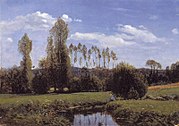
![Mouth of the Seine at Honfleur, 1865, Norton Simon Foundation, Pasadena, California; indicates the influence of Dutch maritime painting.[54]](http://upload.wikimedia.org/wikipedia/commons/thumb/4/42/Claude_Monet_-_Mouth_of_the_Seine.jpg/180px-Claude_Monet_-_Mouth_of_the_Seine.jpg)

![Women in the Garden, 1866–1867, Musée d'Orsay, Paris[55]](http://upload.wikimedia.org/wikipedia/commons/thumb/9/95/Claude_Monet_024.jpg/122px-Claude_Monet_024.jpg)
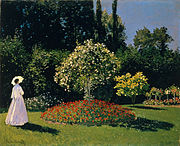
![Garden at Sainte-Adresse ("Jardin à Sainte-Adresse"), 1867, Metropolitan Museum of Art, New York[56]](http://upload.wikimedia.org/wikipedia/commons/thumb/a/a0/Claude_Monet_-_Jardin_%C3%A0_Sainte-Adresse.jpg/180px-Claude_Monet_-_Jardin_%C3%A0_Sainte-Adresse.jpg)
![The Luncheon, 1868, Städel, which features Camille Doncieux and Jean Monet, was rejected by the Paris Salon of 1870 but included in the first Impressionists' exhibition in 1874.[57]](http://upload.wikimedia.org/wikipedia/commons/thumb/9/9e/Claude_Monet_-_The_Luncheon_-_Google_Art_Project.jpg/96px-Claude_Monet_-_The_Luncheon_-_Google_Art_Project.jpg)
![La Grenouillére 1869, Metropolitan Museum of Art, New York; a small plein-air painting created with broad strokes of intense colour.[58]](http://upload.wikimedia.org/wikipedia/commons/thumb/6/67/Claude_Monet_La_Grenouill%C3%A9re.jpg/180px-Claude_Monet_La_Grenouill%C3%A9re.jpg)

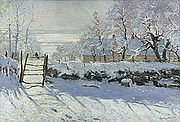
![Le port de Trouville (Breakwater at Trouville, Low Tide), 1870, Museum of Fine Arts, Budapest[59]](http://upload.wikimedia.org/wikipedia/commons/thumb/e/e6/Claude_Monet%2C_1870%2C_Le_port_de_Trouville_%28Breakwater_at_Trouville%2C_Low_Tide%29%2C_oil_on_canvas%2C_54_x_65.7_cm%2C_Museum_of_Fine_Arts%2C_Budapest.jpg/180px-Claude_Monet%2C_1870%2C_Le_port_de_Trouville_%28Breakwater_at_Trouville%2C_Low_Tide%29%2C_oil_on_canvas%2C_54_x_65.7_cm%2C_Museum_of_Fine_Arts%2C_Budapest.jpg)
![La plage de Trouville, 1870, National Gallery, London. The left figure may be Camille, on the right possibly the wife of Eugène Boudin, whose beach scenes influenced Monet.[60]](http://upload.wikimedia.org/wikipedia/commons/thumb/d/df/Claude_Monet_002.jpg/180px-Claude_Monet_002.jpg)
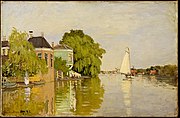
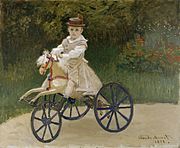
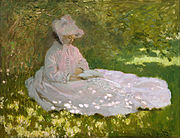

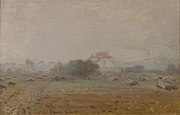
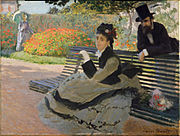
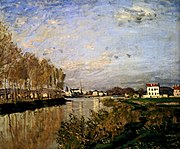


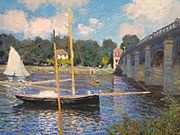


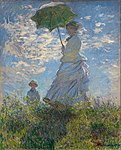


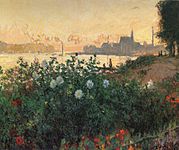


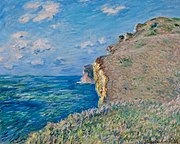


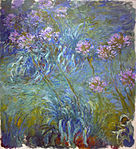
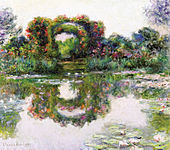
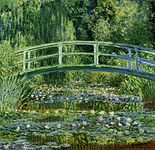
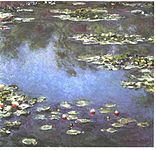



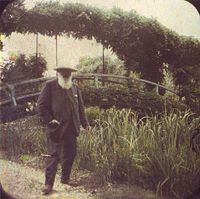


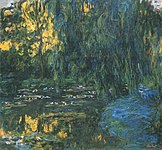
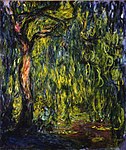


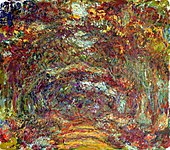



![Arrival of the Normandy Train, Gare Saint-Lazare, 1877, The Art Institute of Chicago,[104] a part of Monet's Gare Saint-Lazare series.](http://upload.wikimedia.org/wikipedia/commons/thumb/f/f2/Claude_Monet_-_Arrival_of_the_Normandy_Train%2C_Gare_Saint-Lazare_-_Google_Art_Project.jpg/180px-Claude_Monet_-_Arrival_of_the_Normandy_Train%2C_Gare_Saint-Lazare_-_Google_Art_Project.jpg)





